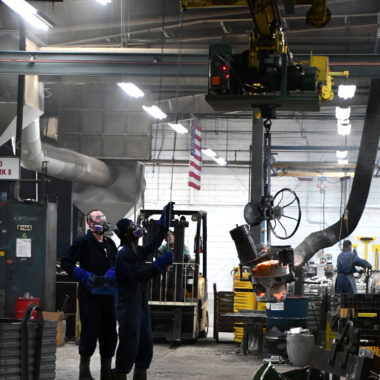Experts in Aluminum Casting Illinois: Boost Your Manufacturing
Wiki Article
Unleash Your Creativity: Ingenious Light Weight Aluminum Casting Methods Revealed
In the world of aluminum spreading, standard techniques have actually long been the norm, however the landscape is moving towards innovation and creativity. By accepting innovative mold and mildew style methods, using innovative 3D printing technology, and even explore hybrid materials, a brand-new world of opportunities is emerging for developers and manufacturers alike. However, truth game-changer depends on the incorporation of IoT for wise casting and the expedition of environment-friendly options. These revelations are not practically improving existing procedures but paving the means for a brand-new period of aluminum casting.Advanced Mold Style Strategies
Advanced mold and mildew design strategies play an essential function in improving the efficiency and high quality of light weight aluminum spreading processes. By including cutting-edge strategies in mold and mildew style, producers can achieve higher precision, improved efficiency, and cost financial savings in their spreading operations. In verdict, the execution of innovative mold layout strategies is crucial for attaining high-grade aluminum castings successfully and efficiently.Using 3D Printing Modern Technology
The usage of 3D printing innovation in aluminum spreading procedures supplies a groundbreaking approach to improving making performance and item high quality. By integrating 3D printing into the light weight aluminum casting workflow, producers can create detailed and intricate mold styles with high accuracy that were previously challenging or impossible to accomplish utilizing conventional approaches.
In addition, 3D printing permits the development of customized mold and mildews tailored to details task demands, allowing higher design adaptability and advancement. This technology opens up brand-new possibilities for developing unique and elaborate light weight aluminum castings that satisfy the needs of contemporary sectors. aluminum casting illinois. Overall, incorporating 3D printing innovation right into aluminum spreading processes presents a considerable possibility for suppliers to streamline production, enhance product quality, and drive development in the area
Trying Out Hybrid Products
Innovatively increasing on the capabilities introduced by 3D printing modern technology in aluminum casting, manufacturers are currently discovering the world of hybrid materials for additional advancements in manufacturing processes. By incorporating traditional light weight aluminum spreading methods with ingenious materials such as polymers, compounds, or porcelains, manufacturers can produce elements with enhanced homes, consisting of enhanced toughness, heat resistance, or lightweight features.The combination of hybrid materials in aluminum casting supplies a myriad of benefits. For instance, making use of ceramic-based products in the mold and mildew style can improve the surface finish of the final aluminum castings, minimizing the requirement for post-processing. Furthermore, incorporating polymers or composites can enhance the general resilience and structural integrity of the elements, increasing the variety of applications where light weight aluminum spreadings can be used.
Via the tactical application of hybrid materials, manufacturers can push the boundaries of typical light weight aluminum casting methods, opening brand-new possibilities for imagination and development in the manufacturing industry. aluminum casting illinois. This experimentation with hybrid products not just enhances the efficiency of light weight aluminum castings but additionally opens up doors to unique layout opportunities and applications
Incorporating IoT for Smart Casting
By harnessing the power of Net of Points (IoT) modern technology, suppliers are transforming the light weight aluminum casting process to develop wise spreading systems that boost efficiency and accuracy. IoT assimilation in light weight aluminum spreading entails installing sensors and actuators in tools to accumulate real-time data on aspects like pressure, circulation, and temperature prices. This data is then evaluated making use of advanced formulas to maximize the casting procedure, causing improved product quality and minimized flaws.
In addition, IoT innovation permits predictive maintenance of casting devices by monitoring efficiency metrics and identifying possible failings early on. This proactive strategy helps reduce downtime and upkeep prices, contributing to general functional efficiency and performance in the aluminum casting market.
Checking Out Eco-Friendly Casting Solutions
With the emphasis on boosting operational performance and sustainability in light weight aluminum spreading procedures, the expedition of environmentally friendly spreading services has come to be a focal factor for producers seeking to more advance their production techniques. Environment-friendly casting options aim to reduce the ecological effect of casting processes by minimizing energy usage, exhausts, and waste generation.Additionally, executing water-based binders in sand spreading molds rather of traditional solvent-based binders can add to a much more lasting spreading process. By adopting these green casting options, manufacturers can not only enhance their environmental stewardship yet additionally potentially understand cost financial savings and operational advantages in the lengthy run.
Conclusion
In conclusion, the cutting-edge aluminum spreading methods reviewed in this short article offer a look right into the future of casting innovation. By including innovative mold and mildew layout techniques, using 3D printing modern technology, try out hybrid products, integrating IoT for clever spreading, and exploring see post eco-friendly remedies, manufacturers can unleash their creativity and press the limits of what is possible this article in the casting market. aluminum casting illinois. These methods open new chances for developing high-grade and intricate aluminum parts with performance and accuracyBy using the power of Web of Points (IoT) technology, producers are revolutionizing the light weight aluminum spreading process to develop clever casting systems that boost performance and accuracy. Additionally, IoT-enabled wise casting systems can immediately readjust specifications based on the information obtained, making sure specific and regular casting outcomes.
With the emphasis on boosting functional effectiveness and sustainability in light weight aluminum casting processes, the exploration of green casting options has become a focal factor for suppliers seeking to further development their production techniques.Furthermore, executing water-based binders in sand spreading molds rather of standard solvent-based binders can add get redirected here to an extra sustainable spreading procedure. By incorporating sophisticated mold and mildew layout techniques, making use of 3D printing modern technology, exploring with hybrid products, integrating IoT for smart casting, and exploring green solutions, producers can unleash their creativity and press the limits of what is possible in the spreading sector.
Report this wiki page